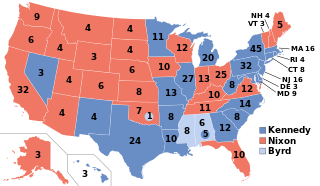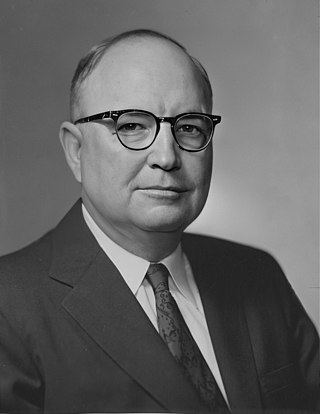
Presidential elections were held in the United States on November 8, 1960. The Democratic ticket of Senator John F. Kennedy and his running mate, Senate Majority Leader Lyndon B. Johnson, narrowly defeated the Republican ticket of incumbent Vice President Richard Nixon and his running mate, U.N. Ambassador Henry Cabot Lodge Jr. This was the first election in which 50 states participated, marking the first participation of Alaska and Hawaii, and the last in which the District of Columbia did not. This made it the only presidential election in which the threshold for victory was 269 electoral votes. It was also the first election in which an incumbent president—in this case, Dwight D. Eisenhower—was ineligible to run for a third term because of the term limits established by the 22nd Amendment.

James Oliver Eastland was an American attorney, plantation owner, and politician from Mississippi. A Democrat, he served in the United States Senate in 1941 and again from 1943 until his resignation on December 27, 1978. Eastland was a segregationist who led the Southern resistance against racial integration during the civil rights movement, often speaking of African Americans as "an inferior race". Eastland has been called the "Voice of the White South" and the "Godfather of Mississippi Politics".

Robert Alphonso Taft Sr. was an American politician, lawyer, and scion of the Republican Party's Taft family. Taft represented Ohio in the United States Senate, briefly served as Senate majority leader, and was a leader of the conservative coalition of Republicans and conservative Democrats who blocked expansion of the New Deal. Often referred to as "Mr. Republican", he co-sponsored the Taft–Hartley Act of 1947, which banned closed shops, created the concept of right-to-work states, and regulated other labor practices.

Julie Nixon Eisenhower is an American author who is the younger daughter of former U.S. president Richard Nixon and his wife, Pat Nixon. Her husband, David, is the grandson of former U.S. president Dwight D. Eisenhower and his wife, Mamie Eisenhower.

William Fife Knowland was an American politician and newspaper publisher. A member of the Republican Party, he served as a United States Senator from California from 1945 to 1959. He was Senate Majority Leader from August 1953 to January 1955 after the death of Robert A. Taft, and would be the last Republican Senate Majority Leader until Howard Baker in 1981.

The Eisenhower dollar is a one-dollar coin issued by the United States Mint from 1971 to 1978; it was the first coin of that denomination issued by the Mint since the Peace dollar series ended in 1935. The coin depicts President Dwight D. Eisenhower on the obverse, and a stylized image honoring the 1969 Apollo 11 Moon mission on the reverse. Both sides were designed by Frank Gasparro, with the reverse based on the mission patch designed by astronaut Michael Collins. It is the only large-size U.S. dollar coin whose circulation strikes contained no silver.

Charles Wayland Brooks was a Republican U.S. Senator from Illinois from 1940 to 1949.

The 1960 Republican National Convention was held in Chicago, Illinois, from July 25 to July 28, 1960, at the International Amphitheatre. It was the 14th and most recent time overall that Chicago hosted the Republican National Convention, more times than any other city.

Dwight D. Eisenhower's tenure as the 34th president of the United States began with his first inauguration on January 20, 1953, and ended on January 20, 1961. Eisenhower, a Republican from Kansas, took office following his landslide victory over Democratic nominee Adlai Stevenson in the 1952 presidential election. Four years later, in the 1956 presidential election, he defeated Stevenson again, to win re-election in a larger landslide. Eisenhower was limited to two terms and was succeeded by Democrat John F. Kennedy, who won the 1960 presidential election.
The 1964 presidential campaign of Barry Goldwater began when United States Senator Barry Goldwater of Arizona elected to seek the Republican Party nomination for President of the United States to challenge incumbent Democratic President Lyndon B. Johnson. Early on, before officially announcing his candidacy for the presidency, Goldwater was accused by Governor of New York Nelson Rockefeller of attempting to galvanize Southern and Western Republican support while neglecting the industrial northern states, eventually becoming one of Goldwater's primary opponents in the race for the Republican Party's nomination in 1964.

The 1988 United States Senate election in Florida was held on November 8, 1988. Incumbent Democratic U.S. Senator Lawton Chiles decided to retire instead of seeking a fourth term. Republican Connie Mack III won the open seat, becoming the first Republican to hold this seat since Reconstruction in 1875.

The 1968 presidential campaign of Richard Nixon, the 36th vice president of the United States, began when Nixon, the Republican nominee of 1960, formally announced his candidacy, following a year's preparation and five years' political reorganization after defeats in the 1960 presidential election and the 1962 California gubernatorial election.
Charles Appleton Meyer was a United States executive who served as Assistant Secretary of State for Inter-American Affairs from 1969 to 1973.
The presidency of Harry S. Truman began on April 12, 1945, when Harry S. Truman became the 33rd president upon the death of Franklin D. Roosevelt, and ended on January 20, 1953.

The 1960 presidential campaign of John F. Kennedy, then junior United States senator from Massachusetts, was formally launched on January 2, 1960, as Senator Kennedy announced his intention to seek the Democratic Party nomination for the presidency of the United States in the 1960 presidential election.

The 1960 United States presidential election in Wyoming took place on November 8, 1960, as part of the 1960 United States presidential election. State voters chose three representatives, or electors, to the Electoral College, who voted for president and vice president.
The following is a timeline of the presidency of Richard Nixon from his inauguration as the 37th president of the United States on January 20, 1969, to December 31, 1969.

The following is a timeline of the presidency of Richard Nixon from January 1, 1970, to December 31, 1970.

The presidential transition of John F. Kennedy began when he won the 1960 United States presidential election, becoming the president-elect of the United States, and ended when Kennedy was inaugurated on January 20, 1961. Kennedy had become president-elect once the election results became clear on November 9, 1960, the day after the election.
The following is a timeline of the presidency of Richard Nixon from January 1, 1971, to December 31, 1971.
















